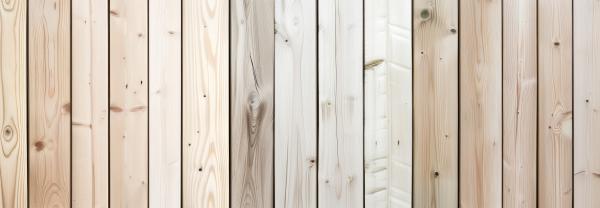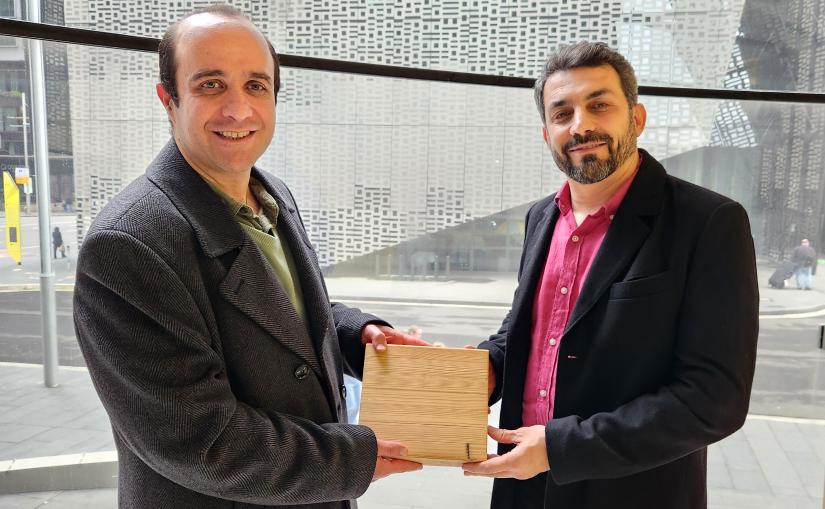Associate Professor Alireza Fini, from the UTS School of Built Environment, spent more than a decade working in the commercial construction industry. Soroush Maghsoudi, Founder and Director of OZ Build Construction, has a Doctor of Philosophy degree in construction engineering.
One is an academic who knows how the construction business works. The other, in the business of construction, knows how academic research works.
Together they’ve invented a new type of dowel-laminated timber (DLT) panelling which, while made from low-grade timbers, can withstand the structural load of a building. They’re now planning to build a facility to fabricate their new product.
“For the building industry, most of a tree is made of low-grade timber that’s not suitable for construction. Only between 20 and 45 per cent of a tree can be used as structural timber,” explains Alireza.
“The rest – between 55 and 80 per cent of a harvested tree – is either wasted or put aside for low value uses. Obviously, this wastage makes the timber used in the construction of buildings more expensive and has worse environmental outcomes.”
The panels are developed using artificial intelligence to design a pattern that locks together with additional structural strength. This means it can be manufactured without the use of glues that can be harmful to the environment.
The product has been successfully tested in the lab, as well as in houses and townhouses, and in buildings up to five stories high, and found to exceed the National Construction Code of Australia’s requirements for structural timber.
“The beauty of our product is you don't use any glue, unlike most other mass timber products on the market. It takes much less time to fabricate and process our panels compared to glued laminated products as there’s no curing or drying time involved,” says Soroush.
“It also means our panels will have the potential to be recycled after being used, which is very expensive if you want to do the same for glue-laminated products.”
“We have different patterns so in terms of the aesthetic it’s very nice It has different structural uses compared with other cross-laminated timber panel products but it has all sorts of supplementary uses. We can use it for walls, floors and even roofs.”
The success of the product comes down to a passion for experimentation and improvement shared by both Alireza and Soroush.
The pair, who had first met when Alireza was working in construction, started work on the panels around eight years ago after a chance meeting at a seminar where they discovered their passion for timber.
“We started talking and realised we were both exploring ways to make engineered timber products more affordable, because current products are expensive,” Alireza says.
“We began looking at different types of timber panelling to see how we can better arrange them to create a whole element that would be strong and structural. We were thinking all the time about how we can manufacture them and how they could comply with the building code.”
“We created designs, tried out different low-grade timber panel boards and tested them. We then fabricated our samples and then did the structural testing again. We ended up running more than 75 different laboratory tests and eventually we achieved perfect results. Then we moved ahead.”
This meant Alireza and Soroush began looking at ways to fabricate the unique panels, bringing together all their nous from years of industry and innovation. But a chance discovery was the spark to make this happen.
“We were studying different manufacturing technologies around the world. Then one day I saw a video of a production line in Switzerland that looked interesting so I got in touch with them,” says Alireza.
“Back then, we were not 100 per cent sure if our method of panelisation could be manufactured. Now after working with them for three years, we have the confidence to move forward.”
We use machine learning algorithms to grade timber, but integration between soft algorithms and hard machines can be very difficult. We’ve had to create 3D models to show how they would work.
This partnership, which has now extended to another three companies, culminated in winning $7.5 million over four years in Cooperative Research Centre Project funding to establish an advanced manufacturing facility to produce the products.
The team are also looking at using robotics and automation in innovative ways by working as part of the recently announced ARC Research Hub for Human-Robot Teaming for Sustainable and Resilient Construction.
It’s the shared vision between Alireza and Soroush that continues to drive their innovation forward.
“There’s good chemistry between me and Ali. I understand the business side of things, he understands academic side and we both understand the engineering,” Soroush says.
“It wasn't easy at first. There was lots of question marks around it at the beginning, and I wasn't sure. Is it worth it to spend this sort of money and time?”
“But from the time we started, I realised something will be achieved. Ali himself is probably the most important element in this collaboration. If it wasn’t for Ali we wouldn't be in this position.”
The feeling is mutual from Alireza.
“Soroush has been so supportive. For a SME, putting their cash into research and development is a big deal. On top of that, Soroush is willing invests his time. Their support was key to making progress in this research,” he says.
“Soroush has a PhD himself so understands research. He’s an entrepreneur and very inquisitive. He finds out all sorts of things on LinkedIn and keeps us updated with what he finds. He’s as curious as I am as a researcher.”
It’s a solid relationship that will continue to push forward.
“The relationship between me and Ali. I think it's ongoing. I don't see it to be finished one day,” Soroush says.



